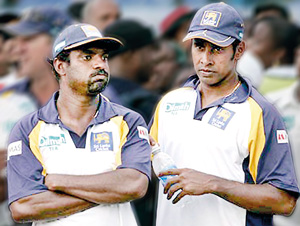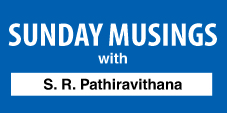Hunting in packs and thinking out of the box
View(s):It was early 1996. At that time the Lankans generally were invited to a tri-series or a cup championship just to make up the numbers. At this instance, the Lankans were in fact in Australia remaining on that soil after their controversial ‘Murali’ Test series. So, then joining the two teams were the West Indies, still one of the strongest sides in the world arena – at least on paper.

The Lankan Champion duo shared 1155 test wickets between them. Now it is upto them to nurture the future bowling generation
The three teams were pitting their wits in the customary new-year ODI tri-series for the Benson and Hedges trophy.
Three of the present selectors were in that Lankan team – Sanath Jayasuriya, Pramodya Wickremasinghe and Hashan Tillekeratne — and they would know better about what my narration is based upon.
The Lankans began on a winning note – beating the West Indies and were beginning to announce their arrival as a lethal force. They had one of the most experienced middle order batting combinations in the world at that time. It comprised Asanka Gurusinha, Aravinda de Silva, Arjuna Ranatunga, Roshan Mahanama and Hashan Tillekeratne. Yet, there was a void at the top.
Then one member of the hierarchy – began to think out of the box. He thought: “We have the middle order. Now Sanath is there and he is a batsman who could get the quick runs; what if we move Romesh Kaluwitharana who is batting well in the lower order, to the opening slot and give the duo the licence to kill. If they fail there is the middle order to stabilise the innings. If the openers click, we catch the rest of the world on the wrong foot.”
He put it to the forum for discussion and follow-up action.
Halfway through the Benson and Hedges series, “Little Kalu” was brought up the order; the move clicked and for the first time Sri Lanka ousted the West Indies and went into the tri-series final against Australia and the rest is World cricket history.
Though the Lankans had a middle order better than the rest of the world, it is the Sanath-Kalu combination that is still talked about in the cricketing world.
It was largely a surprise batting combination that shook the entire cricketing world and brought Sri Lanka the cricket world cup. Yet, the combination that sustained the reputation and told the world that Lankan cricket ascendance was not a ‘flash in the pan’ was a bowling combination.
From 1994 to 2009, during a partnership that lasted fifteen years, the Chaminda Vaas- Muttiah Muralitharan duo formed a deadly combination and shared one thousand one hundred and fifty five (1,155) Test wickets – a feat that many can hardly match. At this point there is no point delving into their ODI exploits.
Generally, it is the bowlers who are largely responsible for wins. Even if a team has the wherewithal to score 500+ runs and if it does not have the bowlers to capture twenty wickets, its exercise becomes futile.Cricket history is studded with bowling combinations. I may not remember all such match-winning combinations, but we can discuss a few.
 Though Vaas and Muralitharan are responsible for more than a thousand Test wickets, you ask about a champion bowling combination even from cricketers who have played the game at the highest level, they would still talk about the Lillee-Thomson Australian combination in fast bowling or the deadly spin combination of India’s Srinivasaraghavan Venkataraghavan, Bhagwat Chandrasekhar, Bishen Bedi and Erapalli Prasanna.
Though Vaas and Muralitharan are responsible for more than a thousand Test wickets, you ask about a champion bowling combination even from cricketers who have played the game at the highest level, they would still talk about the Lillee-Thomson Australian combination in fast bowling or the deadly spin combination of India’s Srinivasaraghavan Venkataraghavan, Bhagwat Chandrasekhar, Bishen Bedi and Erapalli Prasanna.
The Thomson-Lillee combination shared 555 wickets in 70 matches while the Indian spin combination was involved in 231 Test and they captured 853 wickets.
The cricket history is full of such combinations. Combinations like the much feared Holding, croft, Roberts and Garner foursome instilled the fear of the West Indian power in the rest of the world. The Lindwall-Miller combination once again worked wonders for the Australians. The Truman-Statham duo of England, Akram-Younis of Pakistan and Ambrose-Walsh of the West Indies (with 919 wickets between them) are some of the other combinations that I can think of.
In different stages of cricket history, these bowling combinations have combined to bring home victories. Their selectors have emphasised upon their inherent skills and made the maximum out of them.
When it comes to the recent cricket history, the right arm (leg spin and off spin) combination of Anil Kumble and Harbhajan Sing worked for India very effectively. After Kumble retired, Harbhajan seems to have lost his magic.
Coming to the very recent Test matches when England was in India, England lost the first Test and looked as if the Indians were ready to give the Englishmen a good beating. For the second Test off spinner Graeme Swann was joined by left arm orthodox spinner Monty Panesar. The Englishmen went back home with a series win – beating India in India in a Test series.
Then India took on Australia. Off spinner Ravichandran Ashwin who has taken the steering wheel over from Harbhajan was entrusted with an unlikely partner in left arm spinner Ravindra Jadeja. The two bowlers combined to bamboozle Australians. Finally the Australians even could not face the Indian seam attack. They were so demoralised.
What we have been harping from this end is that in any setup, the cricket hierarchy should know what your strengths are and what talent you have at hand and how to maximise it.
Even the chief selector Sanath Jayasuriya was a left arm spinner, but when it came to serious cricket he played his part as a batsman, and left the wicket taking to the frontline bowlers. He bowled only when his services were needed.
A former Test opener who was watching the recent Bangladesh series was an alarmed man. He said: “I cannot see much faults in our batting, but our bowling is well below par and it is alarming.” I endorsed that statement wholeheartedly.
In the last Test that was played at the R. Premadasa Stadium, the Lankans read the wicket wrong and nearly paid the price. But, luckily left armer Rangana Herat stood up alone and changed the course of the game. If not, it would have been cricket history.
The Lankans went in for the game with three frontline pace bowlers and a seamer in Angelo Mathews. The second spinner for the match was T.M. Dilshan. How wrong can a panel of selectors who are experienced Test players be? Tap your heart and ask yourself about it.
Sri Lanka’s first priority now should be to find another bowler who could bowl in tandem with Herat, may be in all forms of the game. In the drawn match at Galle, Herat bowled sixty four overs in one inning. I feel that falls just short of murder.
We need a bowler who could cut down the runs and hold one end on, so that Herat could operate with more breathing space and freedom. The history of cricket has proved over and over again that it has been the bowling combinations that have won matches. Tharindu Kaushal who had a bag full of wickets was brought up to the gate and left at the doorstep for the entire Bangladesh series.
It is our plea to this combination of selectors to find someone to bowl with Herat initially and then also groom another to step into the shoes once Herat decides to call it a day.
The seam bowling that the Lankans have in its larder is not sufficient. We feel none of them is a world class bowler, apart from T-20 specialist Lasith Malinga.
We do have the time now to get Mr. Chaminda Vaas and Mr. Muttiah Muralitharan to walk along the bowling alley and identify the talent at our backyard. They have time till end of May as the ICC has given the IPL window. Let them get the right combination and let bowlers hunt as a pack like the others have done and proved in cricket history.
Follow @timesonlinelk
comments powered by Disqus


















